- Art History
- U.S. History
- World History

Abanindranath Tagore
Abanindranath Tagore (1871-1951) was an Indian painter. He founded the Indian Society of Oriental Art and was its most important artist. He was also the founder of the Bengal School of Art, which is seen as being instrumental in the advent of Indian painting as it is known today. Tagore was concerned that Western artistic styles were exerting too much influence on Indian painters, and promoted a style based instead on a modern interpretation of traditional Rajput and Moghul art. Tagore also wrote several children’s books, which remain popular in Bengal.
Personal Life
In 1890, when he was almost 20 years old, Tagore enrolled at the Calcutta School of Art. While at the renowned school, he was taught especially by two European artists who were employed there as teachers. Charles Palmer taught Tagore how to paint with oils, while O. Ghilardi gave him the benefit of his experience with pastels. By this time, Tagore was a married man, having married Suhasini Devi the previous year. He remained a student at the Sanskrit College for a total of nine years, then moved on to spend a period of 18 months at St. Xavier’s College, where he studied English.
Artistic Development
A little later, Tagore met the English academic and art historian, E. B. Havell. The two men formed a partnership with the aim of modernizing and refreshing the teaching of art at the Calcutta School of Art, a project that received considerable support from Tagore’s brother, Gaganendranath. Tagore felt that Western art was excessively materialistic, and that Indian painting suffered from its close adherence to the British style. In fact, the Pre-Raphaelite movement in Britain itself had already articulated many of the same general ideas as Tagore, although the Indian artist made much of the need for his country to rediscover its own spiritual values and traditions.
Notable Works
Tagore’s earlier pastel works also include some notable portraits. Rabindrath, which he produced in 1892, and Debendranath from a year later are both drawn in the relatively realistic, westernized style that was characteristic of his many of his earlier works. Tagore’s most impressive portrait of this type, however, was completed much later. In the late 1920s, he produced a double portrait of his grandsons. Even though Tagore had by this time become a great admirer of, and advocate for, a distinctively Indian artistic style, he nevertheless produced a portrait which had strong Western influences. The portrait has often been described as showing a certain degree of similarity with paintings from the early years of the Renaissance in Italy.
Newest Additions
- The Beheading of John the Baptist
- Jesus Sends Out His Twelve Apostles
- The Miracle of Healing: Jesus and the Paralytic
- Parables of Wisdom: The Teachings of Jesus
- Jesus’ Response to John’s Disciples
Copyright © 2020 · Totallyhistory.com · All Rights Reserved. | Terms of Use | Privacy Policy | Contact Us
myddoa.com, an art history website
Abanindranath Tagore

Abanindranath Tagore was an Indian artist and writer who lived from 1871 to 1951. Tagore was the first Indian artist to garner worldwide recognition and is often referred to as one of the father’s of modern Indian art. He founded the principles which formed the Bengal school of art.
Tagore was born in Calcutta to a wealthy and distinguished family. His uncle was the noted Indian poet, musician, artist, and Nobel Prize recipient, Rabindranath Tagore. Both his brother and grandfather were also artists. Tagore began his formal art education when he was just 11 years old at Sanskrit College. When he turned 20 in 1890, he left Sanskrit College to continue his education at the Calcutta School of Art.
Tagore’s career began in the 1890s when several of his illustrations were published in magazines. Tagore also illustrated his own books, using watercolors and tempera to create these works. Most of his writings were children’s books. His art and stories elevated the craft. Though Tagore learned the European academic styles of art, he became heavily influenced by the Mughal style of art. The Mughal Empire ruled a majority of the Indian subcontinent between 1526 and 1707. This empire had developed its own school of art which focused on miniature art pieces. It consisted of a unique combination of stylistic features from neighboring regions, such as incorporated into their own.
Tagore wanted to modernize Indian art not only to revitalize it, but to compete with the fast-growing popularity of Western art within India. He saw western art as materialistic. Tagore believed it lacked the spiritual depth that was a prominent feature of Indian art. Tagore subsequently started the ‘Indian Society of Oriental Art’. This was eventually accepted and taught across India. Even the British art schools in India included it to express more progressive Indian values. This school was part of the Swadeshi movement, the Indian nationalism and independent movement that sought to remove the British from their country.
Tagore’s school also helped to form the Bengal school of art. This was a nationalistic art movement that helped pave the way to modern art in India. In this school, Indian artists were encouraged to portray themselves in their art as they saw themselves, as opposed to the western view of “Orientalism”. In 1930, Tagore’s legacy was solidified when he achieved national and worldwide success from the publication of his illustration series based on the ‘Arabian Nights’ stories.
Abanindranath Tagore died in 1951 at 80 years old.

Back to the Artists page .

You can learn about different art movements here .

Share this:
- Click to share on Twitter (Opens in new window)
- Click to share on Facebook (Opens in new window)
- Click to share on Pinterest (Opens in new window)
- Click to email a link to a friend (Opens in new window)
- Click to print (Opens in new window)
- Click to share on Reddit (Opens in new window)
- Click to share on Tumblr (Opens in new window)
Abanindranath Tagore
Aug 7, 1871 - dec 5, 1951, victoria memorial hall, kolkata, discover this artist, related works from the web, bharat mata (1905), en.wikipedia.org bharat mata (painting) - wikipedia, the passing of shah jahan (1902), www.wikidata.org the passing of shah jahan - wikidata, asoka's queen (1910), www.wikiart.org asoka's queen, 1910 - abanindranath tagore - wikiart.org, ganesh janani, www.wikidata.org ganesh janani - wikidata, a moonlight music party (1906), www.wikiart.org a moonlight music party, 1906 - abanindranath tagore - wikiart.org, emperor's march to kashmir, www.wikiart.org emperor's march to kashmir - abanindranath tagore - wikiart.org, the victory of buddha, commons.wikimedia.org file:abanindranath tagore - the victory of buddha, 1914.jpg ..., the final release, www.wikidata.org the final release - wikidata, sindbad the sailor, www.wikidata.org sindbad the sailor - wikidata, more artists, amrita sher-gil, raja ravi varma, nandalal bose, gaganendranath tagore, ramkinkar baij, more mediums, watercolor painting, 50,238 items, 80,134 items, 16,903 items, 54,517 items, 3,344 items, 80,996 items.
- Architecture
- Living Traditions
- Modern & Contemporary Art
- Photography
- Pre-Modern Art
- Prehistoric Era (–7000 BCE)
- Bronze Age (3300 BCE–1200 BCE)
- Iron Age (1200 BCE–200 BCE)
- Ancient Period (200 BCE–500 CE)
- Early Medieval Period (500 CE–1200 CE)
- Late Medieval Period (1200–1500)
- Early Modern Period (1500–1757)
- Modern Period (1757–1947)
- Post Colonial Period (1947–1990)
- Contemporary (1990–)
- Central India
- Eastern India
- Northeastern India
- Northern India
- Northwestern India & Pakistan
- Peninsular India
- Southern India
- Undivided Bengal
- Western India
- Administrators
- Gallerists & Dealers
- Illustrators
- Photographers
- Art History & Theory
- Awards & Recognitions
- Archaeology
- Architecture & Urban Planning
- Art Education
- Art Markets
- Arts Administration
- Books and Albums
- Ceramics & Pottery
- Chemical & Natural Solutions
- Conservation & Preservation
- Decorative Arts
- Display of Art
- Environmental Art
- Events & Exhibitions
- Film & Video
- Gardens & Landscape Design
- Graphic Design & Typography
- Illustration
- Industrial & Commercial Art
- Installation Art
- Interior Design & Furniture
- Liturgical & Ritual Objects
- Manuscripts
- Mixed-Media
- Museums & Institutions
- Mythological Figures
- Painting & Drawing
- Performance Art & Dance
- Prints & Printmaking
- Scenography
- Sculpture & Carving
- Textiles & Embroidery
- Encyclopedia of Art
- Online Courses
- About the MAP Academy
- What is Art History?
- Opportunities at the MAP Academy
- Partnerships
- Terms and Conditions

- Find us on instagram
Mask of Vaikuntha Vishnu, late 5th century. Learn more about 5th century masks

In an attempt to keep our content accurate and representative of evolving scholarship, we invite you to give feedback on any information in this article.
This site is protected by reCAPTCHA and the Google Privacy Policy and Terms of Service apply.
I agree to the terms outlined in the MAP Privacy Policy. I would like to subscribe to the MAP Academy mailing list.
Abanindranath Tagore (b. 1871; d. 1951)

Articles are written collaboratively by the EIA editors. More information on our team, their individual bios, and our approach to writing can be found on our About pages . We also welcome feedback and all articles include a bibliography (see below).
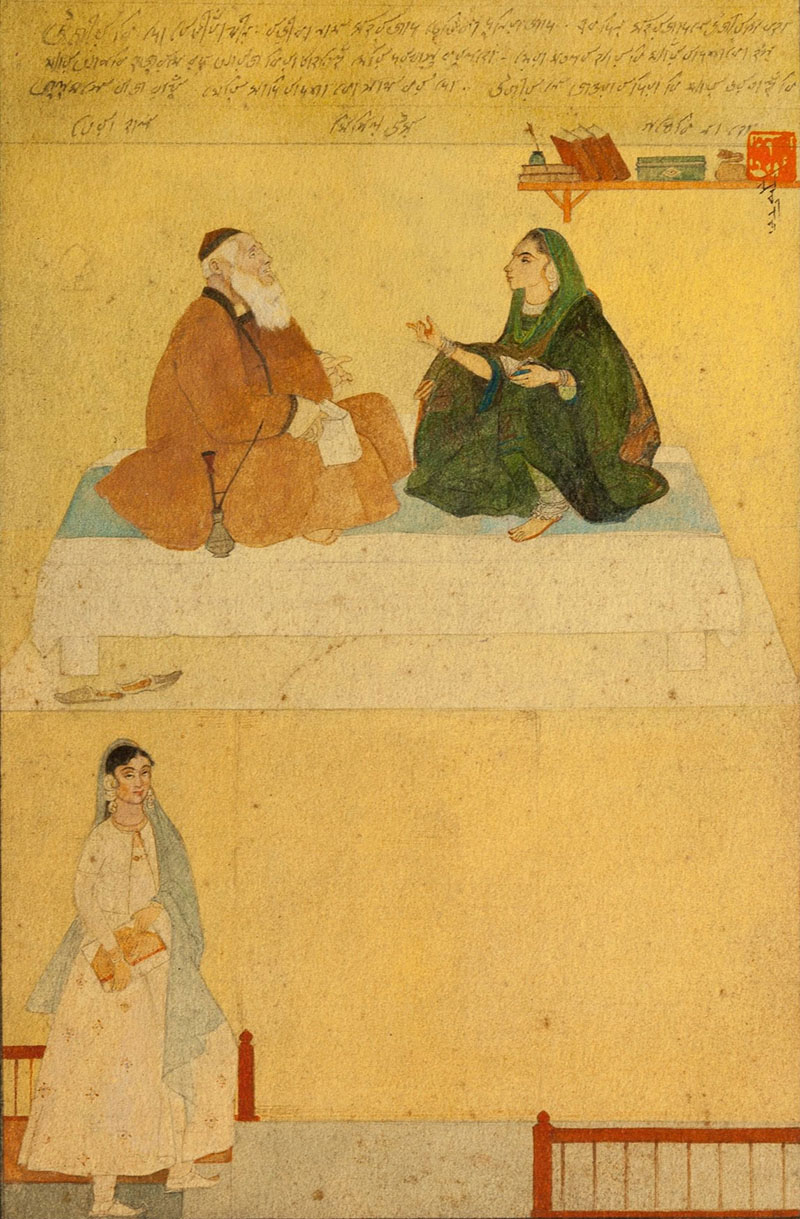
Belonging to the influential Tagore family of Jorasanko, Calcutta (now Kolkata), Abanindranath Tagore emerged as an artist and writer at a time of great political and cultural upheaval in nineteenth-century India. He is credited with the first formal response to European artistic and aesthetic conventions and values, founding and spearheading the Bengal School — a movement that aimed to reimagine a distinctly Indian approach to visual art. Through his paintings, he rejected European and Academic Realism , promoting instead the ideals of Hindu spirituality and aesthetics to convey an authentic ‘Indianness’.
For the development of this framework, he drew inspiration from the Japanese ink wash technique , a sombre colour palette, and stylistic elements from Mughal , Rajasthani and Pahari miniature painting . In his depictions — which included themes from Hindu mythology, history and Indian rural life — he sought to extract a pan-Indian visual motif and identity. As the Bengal School and his practice were contemporaneous with the Swadeshi movement of the early twentieth century, his work is also interpreted through a nationalist lens. This is perhaps most evident in his painting Bharat Mata (1905), which personified India in the form of a divine Hindu deity and went on to become an enduring symbol of the nation and India’s struggle for independence.
Tagore was homeschooled during his early years, and when his talents became evident, he was sent to study art at Sanskrit College, Calcutta in the 1880s. He began his career as an illustrator, with some of his earliest works appearing alongside the poems of his uncles Rabindranath Tagore and Dwijendranath Tagore in the magazine Sadhana in 1892. In 1890, he enrolled in the *Government College of Art and Craft, Calcutta, where he met its principal EB Havell , an Orientalist scholar and pedagogue. Havell had advocated for and secured curricular changes that incorporated the study of Mughal miniatures and emphasised the importance of traditional handicrafts in the syllabi of the fine arts and decorative arts departments, respectively. His search for a unifying image for Indian art that foregrounded tradition over prevalent Indian and Western conventions found resonance in Tagore’s work and outlook. As such, his Modernism emerged as an alternative to that of the Western-influenced painter Raja Ravi Varma , announcing a clear break from the practical, aesthetic and social aspects of colonial art production and distribution.
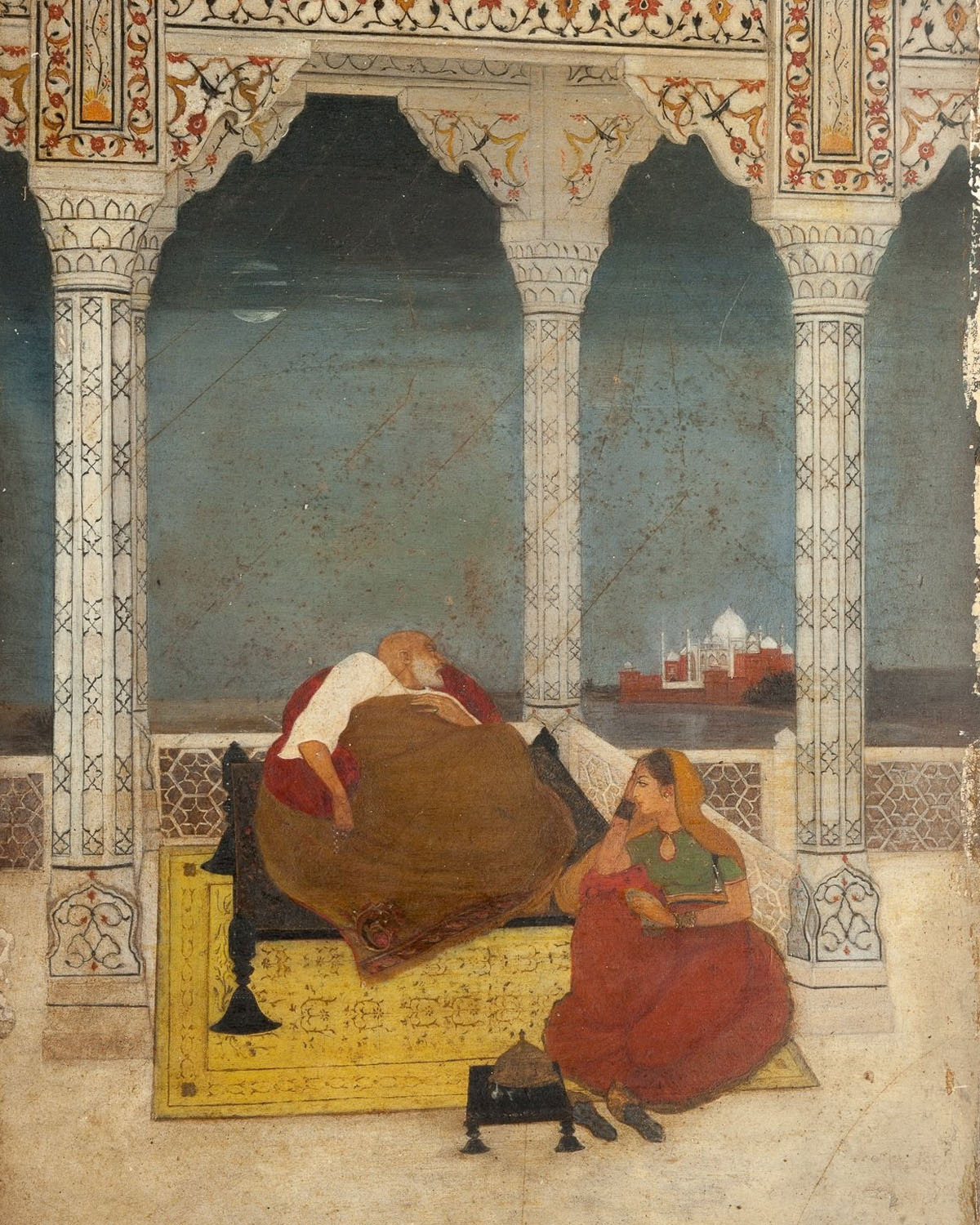
While Tagore’s status continued to be associated with social and cultural privilege, as was the case with Ravi Varma, he began to challenge the conventions within which his art was produced and consumed. Tagore took strict exception to the academic doctrines of life study, oil painting and Realism. He envisioned an environment where an informed and discerning class of art professionals (such as artists, critics and collectors) would be able to produce and consume art free of the demands of formal training, professional success and livelihood. Havell’s continued support of Tagore — in the form of journal articles introducing his works to a European audience and an exhibition of his paintings in the Government Art Gallery, Calcutta — along with AK Coomaraswamy and Sister Nivedita’s endorsements in the journals of Ramananda Chatterjee, Probashi and The Modern Review , brought him and his cause national and international recognition. Accompanying this increased visibility was the establishment of the Indian Society of Oriental Art, which grew organically out of a series of exhibitions of the members of the Bengal School — and with the aid of a number of influential Calcutta-based European Indophiles — around 1907. The Society, by virtue of being the first art salon in India, provided the ideal platform for the consolidation of the ‘Indianising’ agenda of the Bengal School.
In the early experimental phase of his career, Tagore painted the Krishna Leela series (1895–97) based on Jayadeva’s text Geeta Govinda . Inspired by Kalidasa’s lyric poems Meghaduta and Ritusamhara, he painted The Traveller and The Lotus , The Banished Yaksha and The Siddhas from Upper Air . In these, he attempted in different ways — using composition, tone and technique — to inject elements of Romantic Naturalism into canonical pictorial traditions. Paintings that Tagore made in the Mughal miniature style between 1902 and 1905, which incorporated bhava , were met with great success, winning him awards in the Congress Industrial Exhibition (1902–03) and the Delhi Durbar Exhibition (1911). The most celebrated work from this experiment is Passing of Shah Jahan , where the intricate and material image of the Agra Fort stands in stark contrast to the frail and dying figure of Shah Jahan , who is attended to by his daughter Jahanara. The death of Tagore’s daughter during the plague in Calcutta at the end of the nineteenth century had created an impact on the artist that became apparent in the emotive quality of the series, and of this painting in particular. His iconic Bharat Mata painting was modelled after his daughter and directly reflected this loss.
Tagore is famously credited with introducing and promoting the use of the Japanese ink wash technique , which he learnt from the disciples of Japanese artist Okakura Kakuzo, whom the Tagores hosted at Jorasanko in 1903 and who shared his desire for formulating a pan-Asian aesthetic in opposition to Western Realism. His appointment as vice-principal of the Government College of Art in 1905 also allowed him to incorporate Indian painting into the curriculum. This gave a much-needed boost to traditional Indian art forms and nurtured the emergence of modern Indian artists .
By the 1920s, however, as the influence of the Bengal School decreased, Tagore withdrew from public life and into a more personal practice of painting, illustrating and writing. He resigned from his post at the Government College of Art in 1915, but continued to remain active in academia, delivering a series of twenty-nine lectures on Indian art, aesthetics and philosophy at Calcutta University as the Rani Bageswari Professor of Indian Fine Arts between 1921 and 1929. While these developments took place, Tagore continued his artistic practice, distancing himself from the demands of nationalism and the Swadeshi movement. In this final phase of his career, he painted the Playmate (1925) and Pigeon series (1939–40) — landscape and animal studies that explored themes of talking animals and mythological tales inspired by his childhood stories. His Arabian Nights series (1930) recasts the stories of ancient Baghdad in contemporary urban settings. The Kabikankan and Krishnamangal series (1939) are his last known works.
Tagore’s contribution to art and the evolution of an autonomous identity for modernity in India is bolstered by his legacy of children’s literature and illustration. A prolific writer with a gift for narration, Tagore authored and illustrated several books for children and young adults; notable among them are Raj Kahini (1916), Sakuntala and Khirer Putul (1895–96), Nahush and Buro Angla . He also wrote several treatises on art, such as Bharat Silpa Sadanga (‘Six Limbs of Painting’) (1921) and Artistic Anatomy (1914). Towards the end of his career, he released a three-part memoir comprising Apan Katha (published as a book only in 1946), Gharoa (1941) and Jorasankor Dhare (1944), the first of which was authored by him and the others by Rani Chanda, to whom he had narrated the stories.
After his death in 1951, his entire collection of paintings was donated to the Rabindra Bharati Society , where they were kept in storage and not displayed publicly. In the last few decades, the paintings from the second phase of his career have been rediscovered by scholars such as KG Subramanyan , Tapati Guha-Thakurta and R Siva Kumar, who have attempted to read his later work outside the nationalist mould he was cast into during his lifetime.
Bibliography
Our website is currently undergoing maintenance and re-design, due to which we have had to take down some of our bibliographies. While these will be re-published shortly, you can request references for specific articles by writing to [email protected] .
map_academy

Be the first to hear about all the latest MAP Academy articles, online courses and news.
I understand that this site is protected by reCAPTCHA and the Google Privacy Policy and Terms of Service apply, as well as the MAP Academy Privacy Policy

Life of an Art: Abanindranath Tagore

Abanindranath Tagore, a revolutionary artist, contributed significantly to Indian Art throughout the turmoil of history and influenced future generations (Cultural India, no date, & Nandhakumar, 2023). He led a counterculture action against dominating Western Art, where he wanted to revive Indian Art Movements (Nandhakumar, 2023). Abanindranath Tagore enriched Indian Art with talents and creativity inspired by worldwide artistic style, including “techniques of European , Japanese , Rajput, Mughal Persian art and tradition” (ibid). His life story explains why he deserves a worthy eulogy after his death in the name of saving Indian Art (ibid).
Overview of the Artist’s Life and Philosophy | Abanindranath Tagore
Abanindranath Tagore started his Western education in the combination of artistic motivation, where he later aspired to make his career ( Cultural India, no date, & Nandhakumar, 2023). Unfortunately, he gradually became utterly disgusted and bitter with the Western Art movement and orientalism with his revolutionary determination, as shown in Image 1 (Cultural India, no date, & Nandhakumar, 2023). Rebellious, he formulates a new movement following the “common nature” of revolutionizing against the British Raj (Cultural India, no date, Nandhakumar, 2023, & Sharma, 2022). Abanindranath Tagore demonstrated his strong desire to launch a spiritual movement to oppose materialism from the Western counterpart that would have plagued India (Cultural India, no date & Sharma, 2022). He enriched Indian culture by taking the root of true pan-Asian, Hindu, and Buddhist philosophy, which ironically fascinated “British Administrators” and Europeans (Cultural India, no date & Sharma, 2022).
Abanindranath Tagore formed the Benghal School of Art to attract many students; he also developed “children’s literature and art” and significant works to the point of receiving the Nobel Prize in Literature, unthinkable at the time of colonialism (Cultural India, no date, Nandhakumar, 2023, & Sharma, 2022). Yet, Abanindranath Tagore was eccentric as he tried to live a mundane life with his revolution despite the turmoil history of India (Cultural India, no date). His life was exciting and yet calm to note that his lesson on people who inspired to become an artist to live a mundane life and revolutionize what they can do.
Style of Abanindranath Tagore’s Work
Abanindranath Tagore’s style of work is a movement that is inspiring to the Western and Indian world (Nandhakumar, 2023). He utilized the artistic techniques of “The Mughal School of Painting” and Whistler’s Aestheticism” as well as Rajput art forms (Cultural India, no date, & Sharma, 2022). He also integrated with “Chinese and Japanese calligraphic traditions,” some with Tempera and Japanese Wash technique (Cultural India, no date, Nandhakumar, 2023, & Sharma, 2022). Abanindranath does not restrict himself to “Eastern” and “Westerner” Styles (Indian Culture, no date). He explored some mixture of western movements like English Pre-Raphaelite and Art Nouveau (Nandhakumar, 2023). Abanindranath showed his native background and exploration of what is native to him and how he can modernize them inspired by the worldwide art movements from East Asia to Europe (Cultural India, no date).

Most Significant works
Three significant works picturized what Abanindranath Tagore has done in his life. The first one is Bharat Mata referred to as the “chants of Bharat Mata Ki Jai,” using this nationalism, motherhood, and the Benghal movement (Sharma, 2022). “Bharat Mata,” a “Four-armed Hindu Goddess,” was brought significant in 1905 during tough times (Sharma, 2022 Image 2). The second is the “Birth of Krishna,” which represented happiness, ironically made Krisha travail through the trials and horrors of Krishna with the assistance of helpers to overcome the struggle from birth in a dungeon to salvation by others (Sharma, 2022, Image 3). The Last one was the Khagen Babu, where the “middle class” and the people needed to receive attention during colonialism (Sharma, 2022, Image 4). Abanindranath Tagore seemed to tame the fact that nationalism, culture, religion, and commoners are one of many features that is part of Indian art that need to inspire people.
Recognition after death | Abanindranath Tagore
Abanindranath Tagore’s life played a recognized “role model for artists of all generations,” but the recognition is not widespread (Cultural India, no date, & Nandhakumar, 2023). Disgustingly, some paintings are infamously locked away by the authority, “Rabindra Bharati Society Trust,” after Abanindranath Tagore’s death despite his son Alokendranath attempting to put trust for almost all his father’s artworks the authority for safety reasons (Cultural India, no date). There is an effort to revive Abanindranath Tagore’s fame, but tragically not enough to receive his fame for him to deserve recognition (Das, 2023).
Abanindranath Tagore’s Legacy
Abanindranath Tagore has contributed so much; the recognition after death is much more deserving as they are making comments and efforts to raise his legacy with the likes of Rabindranath , which the government made no effort to “celebrate (Das, 2023, & Nandhakumar, 2023). The paintings and sketches, as well as his contribution to independence, had had more influence on India and the rest of the world lest they forget his existence of art (Das, 2023, Sharma, 2022 & Nandhakumar, 2023). One thing is crucial to the future of the art world. He should become famous in history and to the present day for more artwork to inspire more artists to recognize his struggle and effort to bring nationalism to India.

Bibliography
Cultural India (no date) Abanindranath Tagore Biography – Life History, paintings & artwork, facts , Biography – Life History, Paintings & Artwork, Facts . Available at: https://www.culturalindia.net/indian-art/painters/abanindranath-tagore.html (Accessed: March 19, 2023).
Das, S. (2023) Abanindranath Tagore: Garden House of the homing artist restored , Return to frontpage . Available at: https://frontline.thehindu.com/arts-and-culture/heritage/abanindranath-tagore-garden-house-of-the-homing-artist-restored/article66493182.ece (Accessed: March 20, 2023).

India Culture (no date) INDIAN CULTURE . Available at: https://indianculture.gov.in/node/2686756# (Accessed: March 19, 2023).
Kumar, R.S. (no date) STIRworld . STIRworld.com. Available at: https://www.stirworld.com/inspire-people-celebrating-abanindranath-tagore-the-art-teacher-for-a-modern-india (Accessed: March 20, 2023).
Nandhakumar, K. (2023) The man who revolutionised indian art , PRATHA . PRATHA. Available at: https://www.prathaculturalschool.com/post/abanindranath-tagore (Accessed: March 19, 2023).
Sharma, S. (2022) Available at: https://www.simplykalaa.com/post/abanindranath-tagore-indian-artist-who-started-modern-art (Accessed: March 20, 2023).
Tagore, A. (1895) Birth of Krishna , Google . Google. Available at: https://artsandculture.google.com/asset/birth-of-krishna-abanindranath-tagore/4QEwoBmU2gXDTQ (Accessed: March 20, 2023).
Tagore, A. (1905) Bharat Mata (c. 1905) , Wikipedia . Wikimedia Foundation. Available at: https://en.wikipedia.org/wiki/Abanindranath_Tagore#/media/File:Bharat_Mata_by_Abanindranath_Tagore.jpg (Accessed: March 20, 2023).
Tagore, A. (no date) Khagen Babu , Google . Google. Available at: https://artsandculture.google.com/asset/khagen-babu/CgErQKgAAK7mkA?ms=%7B%22x%22%3A0.5%2C%22y%22%3A0.5%2C%22z%22%3A8.650640794341834%2C%22size%22%3A%7B%22width%22%3A3.6378518766756036%2C%22height%22%3A1.2375000000000003%7D%7D (Accessed: March 20, 2023).

Joshua Yae Joon Park wrote about urban planning and architectural articles ranging from urban design to missing middle. After graduating from the University of Waterloo and the University of Western Ontario, Joshua has experience in urban design and planning projects in Southern Ontario.

Why Enterprise Risk Management Is Important to Your Business

Luxury Bathing Experience with Turner Hastings Bathware
Related posts.

Crafting Safe Havens through Designs

Adolf Loos’ Ideas on Architecture and Vienna

Neuroaesthetics: Decoding the Science of Art Appreciation

Architects as Literary Protagonists

The Influence of Greek Mythology on Art and Architecture

The Intersection of Architecture and Other Disciplines
- Architectural Community
- Architectural Facts
- RTF Architectural Reviews
- Architectural styles
- City and Architecture
- Fun & Architecture
- History of Architecture
- Design Studio Portfolios
- Designing for typologies
- RTF Design Inspiration
- Architecture News
- Career Advice
- Case Studies
- Construction & Materials
- Covid and Architecture
- Interior Design
- Know Your Architects
- Landscape Architecture
- Materials & Construction
- Product Design
- RTF Fresh Perspectives
- Sustainable Architecture
- Top Architects
- Travel and Architecture
- Rethinking The Future Awards 2022
- RTF Awards 2021 | Results
- GADA 2021 | Results
- RTF Awards 2020 | Results
- ACD Awards 2020 | Results
- GADA 2019 | Results
- ACD Awards 2018 | Results
- GADA 2018 | Results
- RTF Awards 2017 | Results
- RTF Sustainability Awards 2017 | Results
- RTF Sustainability Awards 2016 | Results
- RTF Sustainability Awards 2015 | Results
- RTF Awards 2014 | Results
- RTF Architectural Visualization Competition 2020 – Results
- Architectural Photography Competition 2020 – Results
- Designer’s Days of Quarantine Contest – Results
- Urban Sketching Competition May 2020 – Results
- RTF Essay Writing Competition April 2020 – Results
- Architectural Photography Competition 2019 – Finalists
- The Ultimate Thesis Guide
- Introduction to Landscape Architecture
- Perfect Guide to Architecting Your Career
- How to Design Architecture Portfolio
- How to Design Streets
- Introduction to Urban Design
- Introduction to Product Design
- Complete Guide to Dissertation Writing
- Introduction to Skyscraper Design
- Educational
- Hospitality
- Institutional
- Office Buildings
- Public Building
- Residential
- Sports & Recreation
- Temporary Structure
- Commercial Interior Design
- Corporate Interior Design
- Healthcare Interior Design
- Hospitality Interior Design
- Residential Interior Design
- Sustainability
- Transportation
- Urban Design
- Host your Course with RTF
- Architectural Writing Training Programme | WFH
- Editorial Internship | In-office
- Graphic Design Internship
- Research Internship | WFH
- Research Internship | New Delhi
- RTF | About RTF
- Submit Your Story
Looking for Job/ Internship?
Rtf will connect you with right design studios.


- Mission & Vision
- Visva Bharati
- Nobel Award
- Educational Ideas
- Tagore's Music
- Tagore's Paintings
- Great Personalities
- Santiniketan
- Photo Gallery
- Bhasha Bhavana
- Vidya Bhavana
- Siksha Bhavana
- Sangit Bhavana
- Kala Bhavana
- Vinaya Bhavana
- Rabindra Bhavana
- Palli Samgathana Vibhaga
- Palli-Siksha Bhavana
- Patha Bhavana
- Siksha Satra
- Granthana Vibhaga
- Centre for Buddhist Studies
- Centre For Endangered Languages (CFEL)
- C.M.E.L.L.C.S.
- A K D Centre for P&D
- Centre For Comparative Literature
- Nippon Bhavana
- Indira Gandhi Centre
- Computer Centre
- Siksha-Charcha
- A. E. R. C.
- C. J. M. C.
- R. K. V. K.
- Women’s Studies Centre
- Faculty List
- Comparative Religion
- A.I.H.C. & A.
- Mathematics
- Computer Science
- Rabindra Sangit
- Hindusthani Classical Vocal
- Kathakali Dance
- Manipuri Dance
- History of Art
- Anthropology
- Indo-Tibetan Studies
- Functional Hindi
- Biotechnology
- Advanced Diploma
- BRIDGE COURSE
- from Silpa Sadan
- from Kala Bhavana
- from Vidya Bhavana
- International Students
- Hostel Fee Structure
- Visitor (Paridarshaka)
- Chancellor (Acharya)
- Rector (Pradhana)
- Vice Chancellor (Upacharya)
- Pro-Vice-Chancellor(Saha-Upacharya)
- Directors & Principals
- Deputy Registrar
- Deputy Registrar (Accounts)
- Dean of Students Welfare
- Advisor to Foreign Student
- University Officers
- Library Officers
- Chief Vigilance Officer
- Coordinator, Admissions
- Karma-Samiti
- Artha-Samiti
- Siksha-Samiti
- Building & Campus Committee
- Central Admission Committee
- Research Board
- Internal Complaints Committee
- Professors Emeritus
- Former Vice-Chancellors
- Students Grievance Redressal Committee (SGRC)
- Music Board
- E-Magazines
- Research_Publication
- Rabindra Rachanabali
- Swaralipi Grantha
- New Publications
- Recent Publications
- Novels by Tagore (Upanyas)
- English Books and Translation by Tagore
- Poems and Songs by Tagore (Kabita O Gaan)
- Prose and Dramas by Tagore (Gadya Natya)
- Stories by Tagore (Galpa)
- Books of Paintings by Tagore
- Dance Dramas by Tagore (Natya Kavya)
- Essays by Tagore (Prabandha)
- Letters by Tagore
- Other Bengali Books
- Other English Books
- Rabindra-Bhavana
- Administrative Resources
- Disability Support
- Computing & Learning
- Placement Assistance, ISERC
- SportsBoard
- Information for Students
- Student Welfare
- Proctor’s Office
- Guest House
- E-Mail ID of Officials
- Telephone Directory

- Events / Photo Gallery
- Download Forms
- Career at VB
- Students Counselling System
- Guest House Booking
- Important Days
+91 8291070650
- WhatsApp Us

Home The Artistic Genius Of Abanindranath Tagore: Rediscovering His Early Works
The Artistic Genius of Abanindranath Tagore: Rediscovering His Early Works
Posted on 19 April, 2023
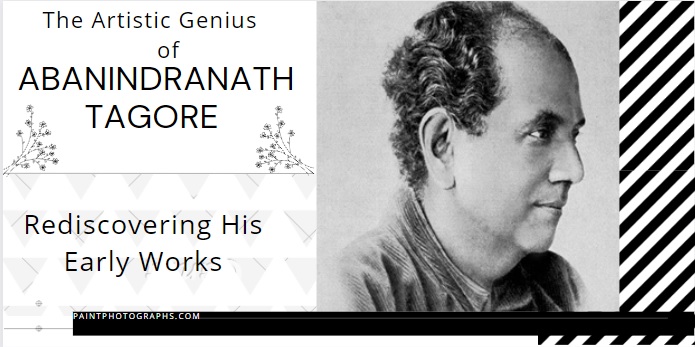
In this post, we discuss the contributions of Ababnindranth Tagore to modern Indian art and his early works of watercolor paintings
Introduction to Abanindranth Tagore
Abanindranth Tagore was one of the most influential artists, authors, and thinkers who radically influenced the direction of Indian art. Founder of the Indian Society of Oriental Art and Bengal School of Art, his contributions to the Indian art movement are immense. In this essay, we will cover his influence on Indian art and his early works.
In one of our earlier essays, we covered the pioneer of Indian art and the romantic paintings Raja Ravi Ravi Varma , known as the Prince among painters and a painter among Princes.
About Raja Ravi Varma’s art, Rabindranath Tagore Nobel laureate, poet, painter, philosopher, and artist said in Chinna Patrabali (12 May 1893), “Today the entire morning went looking at the paintings of Ravi Varma. I liked them very much. The secret of their appeal is in reminding us how precious our own culture is to us in restoring our inheritance.”
Little did Rabindranath Tagore realize his own nephew, Abanindranth Tagore will usher in an art revolution in the country, that will take Indian art on a new trajectory.
The start of the last century was a pivotal moment in the history of Indian art, and it's all thanks to Abanindranath Tagore, who is rightfully hailed as its father. His incredible paintings signify a departure from the Western art styles, prevalent in India at the time, and instead, embrace the rich heritage of our country.
Birth and early life of Abanindranath Tagore
Abanindranath was born on August 7, 1871, in Jorasanko, Calcutta to his mother, Saudamini Devi, and his father, Gunendranath Tagore. He was the nephew of the Noble Laureate poet and philosopher Rabindranath Tagore. Abanindranath's first formal training in pastel, watercolor, and life study was supervised by his private tutor, Signor Gilhardi. For instructions in oil paintings and portraiture, he attended the studio of Charles Palmer, an English painter. In 1895, he painted the Krishna-Lila series, which showcased a unique fusion of European and Indian styles. When E.B. Havell, the principal of the Calcutta School of Art, saw these paintings, he was impressed and offered Abanindranath the position of Vice-principal of the School. Under Havell's guidance, he thoroughly studied Mughal and Rajput styles of painting .
Why is Abanindranath Tagore famous?
Abanindranath Tagore is renowned for his contribution to the Indian art scene as a painter and the creator of the Bengal School of Art (To know more about the history of Bengal School check our earlier post on the history of art movements ). He is known for his unique style that combined traditional Indian techniques with Eastern art concepts, giving birth to a new form of art.
R. Siva Kumar noted art historian, and critic explains Abanindranath’s contributions, 'The social space that Abanindranath narrativized as an artist-flaneur is thus the subject of the Orientalist artist/writer read from the obverse. He reclaims the colonial subjects' right to narrate their stories that was arrogated to themselves by the colonial rulers and perpetuated by presenting their readings as 'objective'. “ In essence, Abanindranth Tagore was perhaps the first Indian artist, to attempt decolonization, long before India’s Independence. And much longer before the word was added to the lexicon
Abanindranath's work has had a significant impact on Indian art, inspiring future generations to embrace their cultural heritage and create art that reflects it.
Abanindranath Tagore's position in Modern Indian art is truly unique and comparable only to his uncle Noble Laureate Rabindranath Tagore in the realm of literature. They both embody the very essence of Indian culture. But what sets them apart was their ability to infuse traditional Indian beliefs and stories with modern forms of beauty and expression. It's awe-inspiring how they both revolutionized their respective fields, leaving an indelible mark on Indian history and culture.
His ability to absorb and assimilate techniques and styles from all over the world is simply uncanny. He fearlessly incorporated the secrets of painting art from both Eastern and Western masters, infusing them with his own unique brand of eclecticism. Harmonizing both Eastern and Western points of view in a way that defies description.
But what truly sets Abanindranath Tagore apart are the leading traits of his miniature paintings. They possess an intensely romantic and lyrical quality, a dreamy and mystical treatment of his subjects that lifts them to a realm far beyond the confines of mere naturalism. It's a testament to his unparalleled skill as an artist, and an inspiration to all who seek to push the boundaries of what is possible in the world of art.
The extremely wide range of his vision theme and techniques makes it very difficult to group his works under any leading characteristics or dominating tendencies. And it is almost impossible to put any label on the general character of Abanindranath Tagore’s works or to characterize the leading phases of his creative brush.
10 Early works of Abanindranath Tagore
The current post is confined to presenting some of the earliest paintings of his pioneering attempt to recover the lost language of Indian aesthetics in Indian art. They are small watercolor paintings. Their subjects are Indian and Eastern. They depict stillness and listening to the within.
These masterpieces were created during the period of 1902-15 when Abanindranath Tagore held the esteemed position of Vice Principal at the Government School of Art in Calcutta. It's truly remarkable how one individual could spark such a profound artistic revolution that would forever shape the course of Indian art. To the extent possible, the paintings are presented chronologically.
The charming painting depicts a lady inspired by the description of the rainy season in Kalidasa's Rtu-Samhara (Seasons), Verse X, was painted in 1892 and represents the artist's earliest attempt at depicting Indian themes in an Indian manner until he discovered the appropriate Indian style.
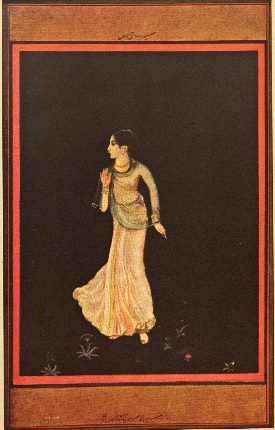
Title: Abhisarika
Creator: Abanindranath Tagore
Date Created: 1892
Physical Dimensions: 9.5 inches x 6.25 inches (24.13 cm x 15.87 cm)
Medium: Water Color on paper
Location: Calcutta Museum, Kolkata, India
In the painting, there is a sense of solidity and realism that reflects the artist's early training in Western art. The figure is dressed in a pink saree with pleated folds and a transparent scarf (Odna) through which the subject's complexion is visible in a sensual manner, inspired by the attire of women common in the region of Uttar Pradesh (also known as United Province in the artist's time) and Bihar. According to Havell," Even if the artist has suggested a Pompeian motif, he has contrived to give a distinctive note by sincere Indian feeling he brings to all his works.”
The artist had the opportunity to study the life and lifestyle of everyday people and villagers during his travel to Monghyr. The sensitive pose and the gesture lend a uniqueness to the figure that is captivating in its Indian essence.
The painting titled "Summer" by Abanindranath Tagore is one of a series of paintings, painted in 1900. Possibly inspired by verse III or verse XXVIII of the summer section of Kalidasa's Rtu-Samhara (Seasons)
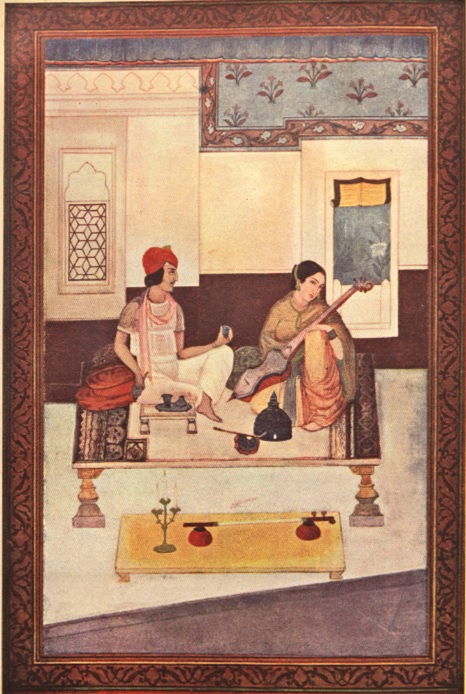
Title: Summer
Date Created: 1900
Physical Dimensions: 9 inches x 6 inches (22.86 cm x 15.24 cm)
The painting depicts a couple wearing traditional costumes that the artist studied in Bihar during his visit to Moghyr. The architectural setting, influenced by Mughal monuments, is used in a way that complements the atmosphere of Kalidasa's mystic romantic descriptions.
The painting "transports us to an old world idyllic scene of grateful shade, delicious music, and cool sherbet, and is thoroughly Indian in style, treatment, and conception."
Another painting from the same series titled "Spring" by Abanindranath Tagore painted in 1900. Possibly inspired by verses X and XI of Kalidasa's Rtu-Samhara (Seasons).
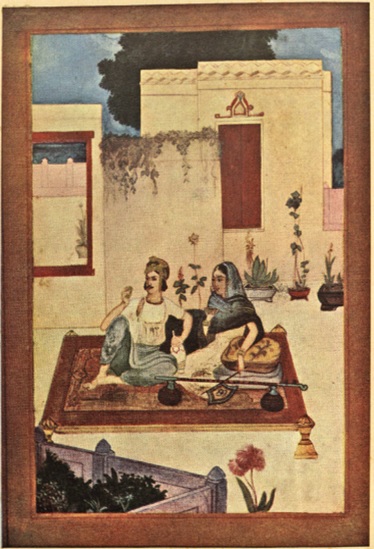
Title: Spring
Physical Dimensions: 6.87 inches x 4.62 inches (17.44 cm x 11.73 cm)
The miniature painting depicts a couple seated in the open courtyard of the house on a carpet (galicha) enjoying a quiet time with each other with drinks in hand. The lady is holding a glass in one hand while her other hand rest on a cushion holding a traditional rural hand fan (haath pankha). The man is holding his glass in one hand and the drinking jar in his other hand, while his back rests on a big side pillow (takia). Shrubs, plants, and flowers can be seen growing around the courtyard symbolizing the spring

Traveler and the Lotus
Another delightful early miniature painting work of Abanindranath Tagore. Painted in 1900, inspired by Kalidasa's Rtu Samhara. The painting depicts a traveler contemplating the beauty of a lotus picked from a nearby pond. Perhaps reminding him of his beloved at his faraway home waiting for him.
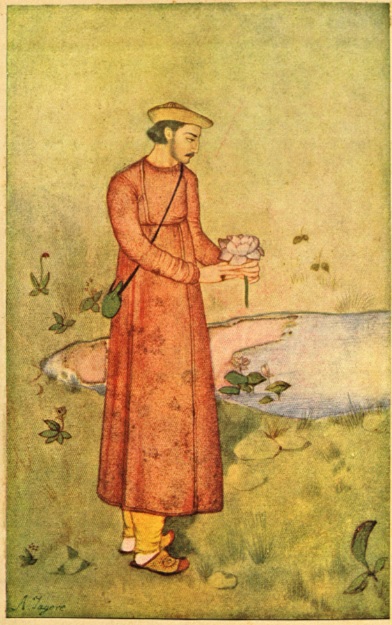
Title: Traveller and the Lotus
Physical Dimensions: 8.25 inches x 5.25 inches ( 20.95cm x 13.33cm)
The influence of Mughal painting, which the artist studied deeply can be clearly discerned from the flowering plants near the edge of the pond. A convention of the Mughal miniature painting. The echo of European training can be observed in the shadow of the standing man, an element the artist will de-emphasize in his mature period. Although the artist is reticent in his work and has yet to find his technique, we can already make out the faint outlines of his technique that will become his signature style.
According to Havell, the drawing, "Shows the unconscious grace and 'naivete' of feelings which are attractive in all of Mr. Tagore's compositions."
Rukmini writing letter to Krsna (Krishna)
The miniature painting, which is of unknown date, is one of the earliest examples of charming color schemes in cool and harmonious color tones. The composition depicts a lady writing a letter while seated on the floor near the evening lamp. The woman depicted is Rukmini, the daughter of the King of Vidarbha. She fell in love with Krsna (Krishna) and secretly chose him as her Lord despite belonging to a rival clan. Complications arose when her brother proposed marriage to Sisupala, Krsna's sworn enemy (Krishna).
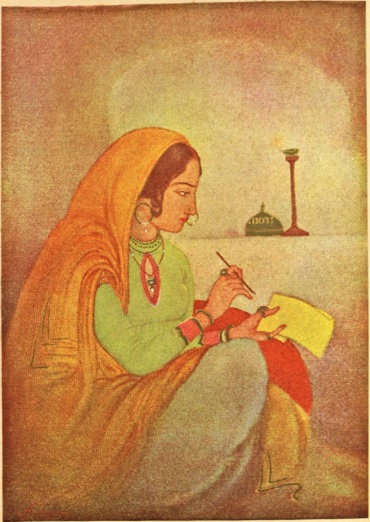
Title: Rukmini writing letter to Krsna (Krishna)
Date Created: Uncertain
Physical Dimensions: 6.5 inches x 4.75 inches (16.51 cm x 12.06 cm)
Saddened by this unhappy development, she wrote a letter to her Lord Krsna (Krishna) pleading with him to come to her rescue and save the situation. Krsna came to her call for help and vanquished Sisupala, carrying Rukmini away and marrying her. The story is based on a scene from the Mahabharata.
It is fascinating to see the narrativization of the story from Mahabharata in painting form. It is even more fascinating to note the two main characters of the story, Rukmini and Krishna, around whom the story revolves, the absence of Krishna. Not even a symbolic hint of Krishna’s presence in the painting. (If you are in the mood to see Krishna paintings check our gallery pages)
Buddha and Sujata
Being a sensitive artist, the spiritual heritage of India would have naturally attracted Abanindranath Tagore. The various Gods and Goddess of India and the Spiritual and holy men (Sadhus) and women (Sadvis) of the country. This miniature painting reflects that. It was painted shortly before the 1903 Delhi exhibition. The painting depicts a scene where Sujata brings votive offerings to Buddha. She mistakes him for the Wood God. The offerings are sweetened milk and rice (payasa). The offerings are presented in a golden bowl. The painting was first exhibited at the Delhi exhibition.
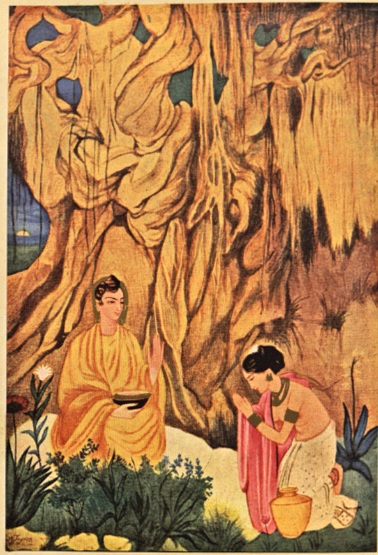
Title: Buddha and Sujata
Date Created: 1903
Physical Dimensions: 7.12 inches x 5 inches (18.08 cm x 12.7 cm)
The composition centers around the Bodhidruma, the banyan tree where Buddha attained his transcendental knowledge which has become the symbol of Buddhahood, characterized by solemnity and majesty. The introduction of the woman with her offering of sweetened milk and rice (payasa) in the composition softens the majesty of the scene. Buddha accepts her offering to break his fast of several weeks. The majestic scene is framed by the scrubs and greenery in the foreground and the giant banyan tree in the background. A glimpse of the sunrise on the left of the background adds a symbolic spiritual element to the lyrical setting of the overall majesty of the painting.
According to Havell, "Mr. Tagore has expressed the serene dignity and spirituality of the Buddha with the same simplicity and depth of feeling he has given to the grace and sweetness of Sujata's adoration.
Another charming and moving composition by Abanindranth Tagore, possibly painted in 1903, is the Dewali (Diwali), the Hindu festival of lights celebrated across India with great enthusiasm.
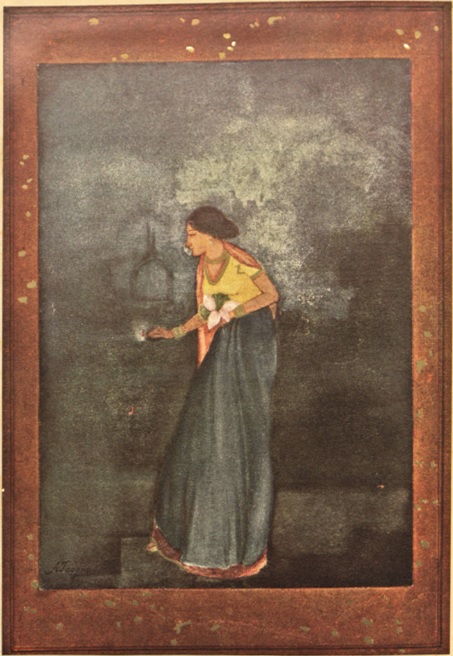
Title: Dewali
Physical Dimensions: 8.5 inches x 6 inches ( 21.51 cm x 15.24 cm)
Medium: Watercolor on paper
The painting depicts a woman descending to the river Ganga with a few lotuses on her left hand and a tiny lamp in her right, in the fading twilight, as darkness falls.
The painting seems to be inspired by the ritual Hindu women undertake during Dipawali, in the month of October (month of Kartik as per the Hindu calendar) when they step down to the waters of the Ganges to float their lamps in honor of Goddess Lakshmi and pray for the good fortune of the family.
The Siddhas of The Upper Air
Possibly painted in 1905, the charming miniature painting is inspired by Kalidas’s Meghduta , (Cloud Messenger)
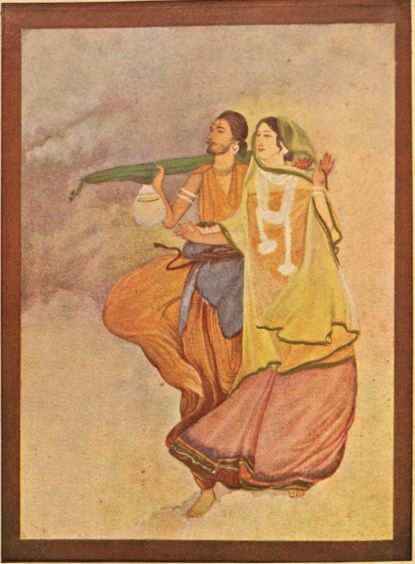
Title: The Siddhas of The Upper Air
Date Created: 1905
Physical Dimensions: 7.75 inches x 5.5 inches ( 19.68cm x 13.97cm)
Commenting on the series of paintings, Ananda Coomaraswamy, the great art historian and pioneer of Indian art history, said, "The tenderness, and grace and unapproachable Indianess of these delicate watercolors is overwhelming. They are the perfect expression of Indian conception in an universal language. They reveal the soul of a people, not crudely or superficially, but utterly; to those that have eyes to see and ears to hear, they have mingled reticence and revelations that belongs to great art. Such work, a true expression of the spirit of Indian nationality, is the perfect flowering of the old tradition, a flower that speaks not only of the past loveliness but is strong and vigorous with promise of abundant fruit."
A scene from Omar Khayyam
The delightful miniature painting is inspired by Omar Khayyam. The painting depicts lovers' quarrel, possibly because the man has arrived late to their rendezvous for their tryst. The lady is clearly annoyed with the man. And the man trying to pacify her by offering her a rose plucked from the nearby rose bush. With the simple yet lyrical setting, the relatable theme, and the subtle brush strokes that will go on to become his signature style, Abanindranth manages to converge the elements to create an ethereal experience for the viewer.
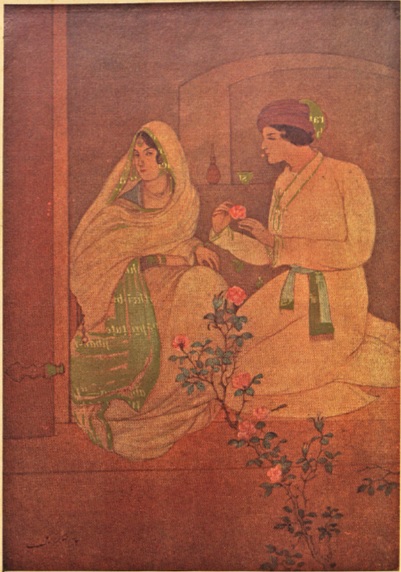
Title: A scene from Omar Khayyam
The painting clearly shows the evolution of the artist and maturity in Ababnindranath's work, with a definite style, texture, and mood. With a flair for drama. According to Havell, "In the illustrations of Omar Khayyam, we see for the first time, Aabanindranath's style. For the first time, we see texture, atmosphere, deep interest in portraiture, and dramatic expression."
Portrait of Abdul Khalik
The painting Portrait of Abdul Khalik is another delightful example of Abanindranth Tagore's style, which blended traditional Indian portrait painting techniques with modern portrait painting influences.
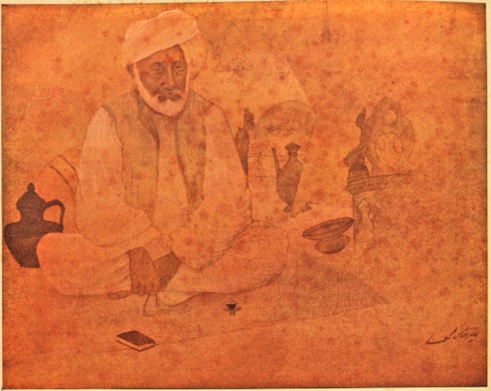
Title: Portrait of Abdul Khalik
Date Created: Unknown
Physical Dimensions: 8 inches x 6.50 inches ( 20.32cm x 16.51cm)
The portrait painting is of Abdul Khalik, an art dealer, an acquaintance of the artist, who had his shop at Park Street Calcutta (now Kolkata). Dressed in the traditional Indian attire of dhoti, kurta, Bundi jacket, and turban. He is shown seated cross-legged in his shop. Surrounded by artifacts, facing the viewer. His right hand holding his prayer beads. A notebook lies near his feet. The composition of the painting is balanced and harmonious.
As can be seen from glimpses of his early works, his repertoire was vast and not amenable to straight jacketing of his works into defined styles, periods, or themes. In other words, Abanindranath’s body of work defies stereotyping. How do then we understand his artworks?
According to noted Indian art historian and art critic, R. Siva Kumar, 'Narration', was central to Abanindranath's art. The narrative impulse, as we have seen, informed both his landscapes and portraits, and they became involved and more engaging when they were inflected with narrative innuendoes.' To understand his artworks, we need to understand the narration behind them and the context of the painting.
R. Sivakumar writes in the introduction to his authoritative book, Paintings of Abanindranath Tagore (2008) that Abanindranath is an artist "' who is more talked about than seen. In this, he is like a classic that is little read but is a part of our cultural consciousness.”
Our endeavor with this post was to introduce and appreciate Ababnindranth Tagore's contributions to a new generation of art lovers through his early works.
And if it inspires a few of our readers to learn more about this great artist, we will consider our job well done.
If you wish to order a custom handmade oil portrait painting or an oil painting you can visit our order now page . Custom handmade oil portrait paintings make for memorable gifts like a wedding portrait painting or an engagement portrait or birthday portrait painting or a housewarming gift . And commemorative, like memorial portrait painting . Our talented artists can also create composite oil painting portraits from two or more reference photos and pics. Similarly, we can also create pet portrait paintings or create new portrait paintings from blurry old black-and-white photos .
To know the prices of our portrait paintings you can visit our pricing page . To see our work on portrait paintings you can visit our gallery pages . To connect with us ping us on our chat messenger on the website or ping us on Whatsapp or call us at 918291070650 or drop us an email at [email protected]
If you are an art aficionado and interested to write a guest post for us, connect with us.
Thank you for reading. You may also enjoy our other pieces. Subscribe to us and get notified when new pieces are published.
For notes and references, please refer to the Notes and Reference section
Recommended Pieces
Uncover the mystical beauty of Shri Krishna paintings and art through the ages | Paintphotographs
A Closer Look at the Stunning Paintings in Coca-Cola's Latest Ad “Masterpiece” | Paintphotographs
Ultimate 20 Best Oil Portrait Paintings of John Singer Sargent (Ranked) | Paintphotographs
How to Commission a Wedding Portrait Painting Online | Paintphotographs
The life and paintings of artist and painter KCS Paniker | Paintphotographs
Why is the Monalisa so famous? Monalisa's portrait painting history | Paintphotographs
Memorial Paintings - The Ultimate Guide to Commissioning one | Paintphotographs
Notes and reference section
Chhinna Patrabali
https://www.google.co.in/books/edition/A_History_of_Indian_Painting/McSbSMhArFgC?hl=en&gbpv=1
Abanindranath Tagore
Abanindranath Tagore his Early Work | INDIAN CULTURE
https://www.google.co.in/books/edition/Atlas_of_World_Art/O3h2KfXoOPYC?hl=en&gbpv=1&pg=PA304&printsec=frontcover
https://www.google.co.in/books/edition/Paintings_of_Abanindranath_Tagore/Pdb_nQEACAAJ?hl=en

Beautiful memories recreated in form of paintings. I had requested them to create a painting combining two different photos and they aced it. Really happy with their work and highly recommend it.
Anjanee Ambegaonker
Love be a part of you. Excellent work , the painting was beautiful it's amazing . She was very happy when I gifted. THNXX
They did the amazing and much perfect professional work .They can do any kind of sketching and gives life to our ideas ♥️
The Team Of PaintPhotographs specially Sweta ji is Amazing & his Works are Speechless. My Personal Experience is Good
They make our missing people be with us Love your work and the way you approach during making the painting.
Manivannan Indrany
Professional work done. Oil painting looks better then the original photograph. Awesome work, highly recommended.
Raghavendra M
Paintings look very realistic and delivered on time as committed. Great work
bharath ramakrishna
It's very good and looking as it is and very thankful to Swetha for good conversation and I satisfied for the money and again thank you so much Swetha
venkatesh nagineni
- Order Your Painting
- Refund Policy
- Privacy Policy
- Terms of use
- Shipping and Delivery
- Krishna Paintings
- Oil Portraits of Gurus| Saints | Holy Men
- Mother's Day Gift Of Painting
- Retirement Painting | Farewell Painting
- Painting for Housewarming
- Birthday Painting Gift
- Anniversary Painting Gift
- Black and White Portrait Painting
Latest Articles
- Hemendranth Majumdar and his Wet Sari paintings: Last Romantic Naturalist Artist
- 25 Luxury Wedding Gifts For Couples In India
- Making of a Family Painting from a 100 Year Old Photo: Reviving the Past
- 100 Years of Bharat Mata: 9 Iconic Indian Artworks by Legendary Artists
© 2022. All rights reserved. Beamers Digital Media Pvt Ltd.

Skip to main content
- Select your language English हिंदी
Social Share

Abanindranath Tagore
Keywords: Modern Painting Artwork
Publisher: National Gallery of Modern Art, New Delhi
Description: This painting is created by an Indian artist Mukul Dey. The artist signed 'Mukul Dey' in English at the bottom right corner of the painting with a pencil. Also inscribed 'Sri Abanindranath Tagore' in Bengali and '12/9/17' in English with pen and ink. This superbly executed profile portrait is of Abanindranath Tagore. The solemn expression in the eyes of Abanindranath is depicted with great ease and skill.
Type: Painting
Received From: National Gallery Of Modern Art, New Delhi
- Dublin Core View

Indian Institute of Technology Bombay

- Phone . [email protected]
- Email . +54 356 945234
Indian Culture App

The Indian Culture Portal is a part of the National Virtual Library of India project, funded by the Ministry of Culture, Government of India. The portal has been created and developed by the Indian Institute of Technology, Bombay. Data has been provided by organisations of the Ministry of Culture.
Email Id : [email protected]
Biography Online

Rabindranath Tagore
Poet, writer and humanitarian, Rabindranath Tagore was the first Indian to be awarded the Nobel Prize for Literature and he played a key role in the renaissance of modern India. Tagore is most widely known for his poetry, but he was also an accomplished author of novels, short stories, plays and articles. He took an active interest in a widespread range of social, cultural and artistic endeavours. He has been described as one of the first Twentieth Century’s global man.
“So I repeat we never can have a true view of man unless we have a love for him. Civilisation must be judged and prized, not by the amount of power it has developed, but by how much it has evolved and given expression to, by its laws and institutions, the love of humanity.”
Sadhana: The Realisation of Life, (1916)
Short Biography Rabindranath Tagore
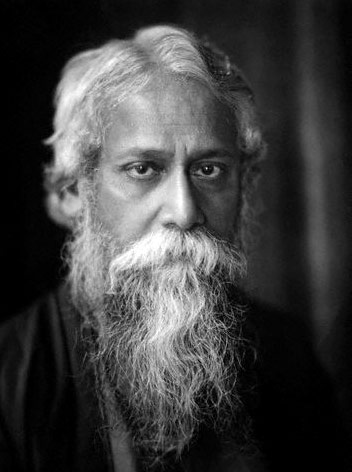
Rabindranath began writing from an early age and impressed with his free-flowing style and spontaneous compositions. He mostly rejected formal schooling; he spent much time being taught at home. In 1878 he travelled to England and sought to study law at University College, London, but he left before finishing the degree.
After returning to India, in 1901, Tagore moved to Shantiniketan to found an ashram which became his focal point for writing and his view on schooling. He chose the name for the ashram – Shantiniketan meaning ‘Abode of Peace.’
“Love is the ultimate meaning of everything around us. It is not a mere sentiment; it is truth; it is the joy that is at the root of all creation.”
– Tagore, Sādhanā : The Realisation of Life (1916)
Friendship with Gandhi
Tagore was firm friends with Gandhi and admired him very much. But, despite this friendship, he could be critical of his views. For example, he disagreed with Gandhi’s views on Swaraj protests and upbraided Gandhi when Gandhi claimed an earthquake was ‘divine retribution for the mistreatment of Dalits in India.’ Yet despite the frequent divergence of opinions, they could admire each other. When Gandhi went on a fast unto death, it was Tagor who was able to persuade Gandhi to give up his fast and look after his health.
Nobel Prize for Literature 1913
In 1913, Tagore was awarded the Nobel Prize for literature for his work ‘ Gitanjali ‘ This made his writings internationally known and his fame spread throughout the world.
“My debts are large, my failures great, my shame secret and heavy; yet I come to ask for my good, I quake in fear lest my prayer be granted.” – Gitanjali
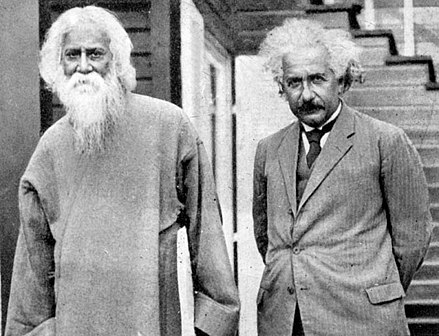
Rabindranath Tagore with Einstein
This gave Tagore the opportunity to travel extensively giving lectures and recitals in many different countries. He also became acquainted with many of the leading cultural contemporaries of the day; this included W.B.Yeats, George Bernard Shaw , Romain Rolland, Robert Frost and Albert Einstein .
Tagore had a great love for nature and many of his poems invoke the simple beauties of the natural world. For Tagore, his religion could be found in the wonders and mysteries of nature – as much as in temples and sacred books.
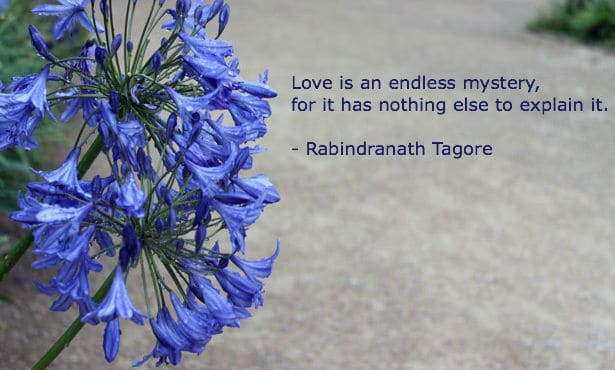
Tagore was a prolific composer of music. He composed over 2,000 songs which have been popularised and sung widely across Bengal. Like his literature, he broke away from classical constraints to offer a great emotive and spiritual appeal. Tagore is unique for being the official composer for the national anthem of two countries – India’s Jana Gana Mana and Bangladesh’s Amar Shonar Bangla .
Tagore was an opponent of British imperialism, though he also felt Indians had a duty to improve their self-education; he said that British rule was partly due to the state India had fallen into. In particular, he was very denigrating about India’s obsession with caste.
‘the ultimate truth in man is not in his intellect or his possessions; it is in his illumination of mind, in his extension of sympathy across all barriers of caste and colour, in his recognition of the world, not merely as a storehouse of power, but as a habitation of man’s spirit, with its eternal music of beauty and its inner light of the divine presence.’ – Tagore, The Poet’s Religion’ in Creative Unity (1922) [ 1 ]
In 1919, Tagore returned his knighthood in protest at the Jallianwala Bagh Massacre, in which many peaceful Indian protesters were killed.
Tagore was a polymath, and towards the end of his life he took up art and also pursued an interest in science. Tagore was also very much an internationalist, criticising nationalism, though also writing songs and articles in support of the general principle of the Indian independence movement.
“Patriotism cannot be our final spiritual shelter; my refuge is humanity. I will not buy glass for the price of diamonds, and I will never allow patriotism to triumph over humanity as long as I live. “
– Rabindranath Tagore
Tagore view on Religion
Tagore had mixed views on religion. He was brought up in a traditional Hindu family and taught to pray and meditate from an early age. He remembers the peace of mind he developed from chanting the Gayatri Mantra, but at the same time was detached from the more formalistic aspects of religion. He tended to see religion as not scriptures and places of worship but the life we lead. As he explained:
“My religion is my life – it is growing with my growth – it has never been grafted on me from outside.” ~ Tagore to Robert Bridges, 8 July 1914.
He was keen to avoid any fanaticism and saw the strength of his own Hindu religion as its ability to see more than one path to the goal. His life-long aspiration was to see a harmony of religions flourish in India – not from mere tolerance but an appreciation of the different merits other religions had.
‘The Idea of freedom to which India aspired was based upon realization of spiritual unity…India’s great achievement, which is still stored deep within her heart, is waiting to unite within itself Hindu, Moslem, Buddhist and Christian, not by force, not by the apathy of resignation, but in the harmony of active cooperation.’ ~ Tagore in Berlin, 1921.
However, he was also critical of the Hindu caste system.
Tagore’s poetry frequently hint at a mystical view of the world.
“In this playhouse of infinite forms I have had my play, and here have I caught sight of him that is formless.” – Gitanjali “The human soul is on its journey from the law to love, from discipline to liberation, from the moral plane to the spiritual.” Sādhanā : The Realisation of Life (1916)
Tagore died on 7th August 1941, after a long and painful illness, aged 80. He died in his family home.
Citation: Pettinger, Tejvan . “ Rabindranath Tagore ”, Oxford, UK www.biographyonline.net , 1st Jun. 2009. Last updated 1 March 2019.
Stories From Tagore
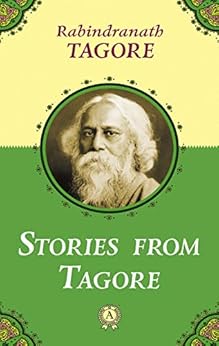
Stories From Tagore at Amazon
The Essential Tagore

The Essential Tagore at Amazon
Related pages

External Links
- Short poems of Rabindranath Tagore
- Tagore Bio at Nobel.org
We will keep fighting for all libraries - stand with us!
Internet Archive Audio

- This Just In
- Grateful Dead
- Old Time Radio
- 78 RPMs and Cylinder Recordings
- Audio Books & Poetry
- Computers, Technology and Science
- Music, Arts & Culture
- News & Public Affairs
- Spirituality & Religion
- Radio News Archive

- Flickr Commons
- Occupy Wall Street Flickr
- NASA Images
- Solar System Collection
- Ames Research Center

- All Software
- Old School Emulation
- MS-DOS Games
- Historical Software
- Classic PC Games
- Software Library
- Kodi Archive and Support File
- Vintage Software
- CD-ROM Software
- CD-ROM Software Library
- Software Sites
- Tucows Software Library
- Shareware CD-ROMs
- Software Capsules Compilation
- CD-ROM Images
- ZX Spectrum
- DOOM Level CD

- Smithsonian Libraries
- FEDLINK (US)
- Lincoln Collection
- American Libraries
- Canadian Libraries
- Universal Library
- Project Gutenberg
- Children's Library
- Biodiversity Heritage Library
- Books by Language
- Additional Collections

- Prelinger Archives
- Democracy Now!
- Occupy Wall Street
- TV NSA Clip Library
- Animation & Cartoons
- Arts & Music
- Computers & Technology
- Cultural & Academic Films
- Ephemeral Films
- Sports Videos
- Videogame Videos
- Youth Media
Search the history of over 866 billion web pages on the Internet.
Mobile Apps
- Wayback Machine (iOS)
- Wayback Machine (Android)
Browser Extensions
Archive-it subscription.
- Explore the Collections
- Build Collections
Save Page Now
Capture a web page as it appears now for use as a trusted citation in the future.
Please enter a valid web address
- Donate Donate icon An illustration of a heart shape
Rabindranath Tagore : a biography
Bookreader item preview, share or embed this item, flag this item for.
- Graphic Violence
- Explicit Sexual Content
- Hate Speech
- Misinformation/Disinformation
- Marketing/Phishing/Advertising
- Misleading/Inaccurate/Missing Metadata
![[WorldCat (this item)] [WorldCat (this item)]](https://archive.org/images/worldcat-small.png)
plus-circle Add Review comment Reviews
64 Previews
2 Favorites
DOWNLOAD OPTIONS
No suitable files to display here.
PDF access not available for this item.
IN COLLECTIONS
Uploaded by station45.cebu on May 5, 2023
SIMILAR ITEMS (based on metadata)

IMAGES
VIDEO
COMMENTS
R. Siva Kumar's Paintings of Abanindranath Tagore (2008) is a path-breaking book redefining Tagore's art. Another book that constitutes a serious reconsideration of Tagore's art, contextualising it as a critique of modernity and the nation-state is Debashish Banerji's The Alternate Nation of Abanindranath Tagore (2010).
Abanindranath Tagore was born in the Jorasanko town of Bengal. Being the younger brother of Gaganendranath Tagore, an eminent artist, Abanindranath was introduced to art early in his life. Since he grew up amidst the famous Tagore family, art and literature were always a part of his childhood and he inevitably developed a liking towards them.
Abanindranath Tagore Born Aug. 7, 1871 Calcutta, West Bengal, India Died Dec. 5, 1951 (at age 80) Nationality Indian Movement Bengal school of art Field Painting, writing Works View Complete Works Abanindranath Tagore (1871-1951) was an Indian painter. He founded the Indian Society of Oriental Art and was its most important artist. He was also
In 1891 Tagore went to East Bengal (now in Bangladesh) to manage his family's estates at Shilaidah and Shazadpur for 10 years. There he often stayed in a houseboat on the Padma River (the main channel of the Ganges River), in close contact with village folk, and his sympathy for them became the keynote of much of his later writing.Most of his finest short stories, which examine "humble ...
ABANINDRANATH TAGORE (7 August 1871 - 5 December 1951) The nephew of Rabindranath Tagore and the younger brother of the celebrated artist Gaganendranath Tagore, Abanindranath Tagore was the principal artist and creator of the 'Indian Society of Oriental Art' and the first major exponent of swadeshi values in Indian art. He was the foundational ...
Tagore was born in Calcutta to a wealthy and distinguished family. His uncle was the noted Indian poet, musician, artist, and Nobel Prize recipient, Rabindranath Tagore. Both his brother and grandfather were also artists. Tagore began his formal art education when he was just 11 years old at Sanskrit College. When he turned 20 in 1890, he left ...
Abanindranath Tagore was the principal artist and creator of the "Indian Society of Oriental Art". He was also the first major exponent of Swadeshi values in Indian art. He founded the influential Bengal school of art, which led to the development of modern Indian painting. He was also a noted writer, particularly for children. Popularly known as 'Aban Thakur', his books Rajkahini, Buro Angla ...
Aug 7, 1871 - Dec 5, 1951. Abanindranath Tagore CIE was the principal artist and creator of the "Indian Society of Oriental Art". He was also the first major exponent of Swadeshi values in Indian art, thereby finding the influential Bengal school of art, which led to the development of modern Indian painting.
Belonging to the influential Tagore family of Jorasanko, Calcutta (now Kolkata), Abanindranath Tagore emerged as an artist and writer at a time of great political and cultural upheaval in nineteenth-century India. He is credited with the first formal response to European artistic and aesthetic conventions and values, founding and spearheading ...
Other articles where Abanindranath Tagore is discussed: South Asian arts: Modern period: Its leading artist was Abanindranath Tagore and its theoretician was E.B. Havell, the principal of the Calcutta School of Art. Nostalgic in mood, the work was mainly sentimental though often of considerable charm. The Bengal school did a great deal to reshape contemporary taste and to make Indian artists…
Abanindranath Tagore's Legacy. Abanindranath Tagore has contributed so much; the recognition after death is much more deserving as they are making comments and efforts to raise his legacy with the likes of Rabindranath, which the government made no effort to "celebrate (Das, 2023, & Nandhakumar, 2023).The paintings and sketches, as well as his contribution to independence, had had more ...
Rabindranath Tagore reworked his play 'Raja Rani' written much earlier into a new drama called 'Tapati' in 1929. The play was staged the same year in which Rabindranath also played the role of Vikramjit in the play. Abanindranath Tagore visually documented all of Rabindranath's dramatic productions. He also painted several mask drawings.
Rabindranath Tagore FRAS (/ r ə ˈ b ɪ n d r ə n ɑː t t æ ˈ ɡ ɔːr / ⓘ; pronounced [roˈbindɾonatʰ ˈʈʰakuɾ]; 7 May 1861 - 7 August 1941) was a Bengali polymath who was active as a poet, writer, playwright, composer, philosopher, social reformer, and painter during the age of Bengal Renaissance. He reshaped Bengali literature and music as well as Indian art with Contextual ...
Abanindranath was born in Jorasanko, Calcutta on 7 August 1871. His father Gunendranath was the son of Girindranath, the second son of Dwarkanath Tagore. Abanindranath's first formal training in pastel, watercolour and lifestudy was under the supervision of his private tutor, Signor Gilhardi. He attended the studio of Charles Palmer, an English ...
Abanindranath was born on August 7, 1871, in Jorasanko, Calcutta to his mother, Saudamini Devi, and his father, Gunendranath Tagore. He was the nephew of the Noble Laureate poet and philosopher Rabindranath Tagore. Abanindranath's first formal training in pastel, watercolor, and life study was supervised by his private tutor, Signor Gilhardi.
Rabindranath Tagore, also known as Gurudev, was a Bengali polymath who made great contribution to Indian literature, music, as well as art. He was awarded the Nobel Prize for Literature in 1913. Let's take a look at his childhood, life history, works and achievements. Cultural India : Indian Art : Indian Painters : Rabindranath Tagore.
Abanindranath Tagore. Publisher: National Gallery of Modern Art, New Delhi. Description: This painting is created by an Indian artist Mukul Dey. The artist signed 'Mukul Dey' in English at the bottom right corner of the painting with a pencil. Also inscribed 'Sri Abanindranath Tagore' in Bengali and '12/9/17' in English with pen and ink.
Short Biography Rabindranath Tagore. Rabindranath was born on 7 May 1861 Calcutta. His father Debendranath Tagore was a leading light in the Brahmo Samaj - a reforming Hindu organisation which sought to promote a monotheistic interpretation of the Upanishads and move away from the rigidity of Hindu Orthodoxy which they felt was holding back ...
Abanindranath Tagore, like his elder brother, Gaganendranath (1867-1938)—both belonging to the illustrious Tagore family of Kolkata's Jorasanko area and nephews of Rabindranath—sought to create a unique Indian style in art and literature freed from the strictures of Western aesthetics. Abanindranath had a talent for retelling stories set ...
Rabindranath Tagore wrote various poetry, novels, and short tales throughout his lifetime. Though he began writing at an early age, his ambition to produce more creative works only grew after the loss of his wife and his children. The following are a few of his literary works: Novels: His books are believed to be the most underappreciated of ...
Rabindranath Tagore : a biography by Dasgupta, Uma. Publication date 2004 Topics Tagore, Rabindranath, 1861-1941, Authors, Bengali -- Biography Publisher New Delhi ; New York : Oxford University Press ... Be the first one to write a review. 64 Previews . 2 Favorites. DOWNLOAD OPTIONS No suitable files to display here. ...
Online Edition Of the Works of Abanindranath Thakur